Human Resource Management at Google: Recruitment, Retention, and More
VerifiedAdded on 2023/01/23
|17
|5392
|22
Report
AI Summary
This report provides a detailed analysis of Google's human resource management (HRM) practices. It begins with an introduction to HRM and provides background information on Google. The report then delves into Google's specific HRM strategies, including recruitment and selection processes, performance management systems (focusing on OKRs and 360-degree feedback), and employee retention and motivation techniques, highlighting the importance of psychological safety and workplace flexibility. Recommendations for improvement are offered, touching upon performance management, work-life balance, and recruitment and retention strategies. The report concludes with a summary of the key findings, emphasizing Google's innovative approach to managing its workforce and its success in attracting and retaining talented employees. The report uses academic sources to support its findings.
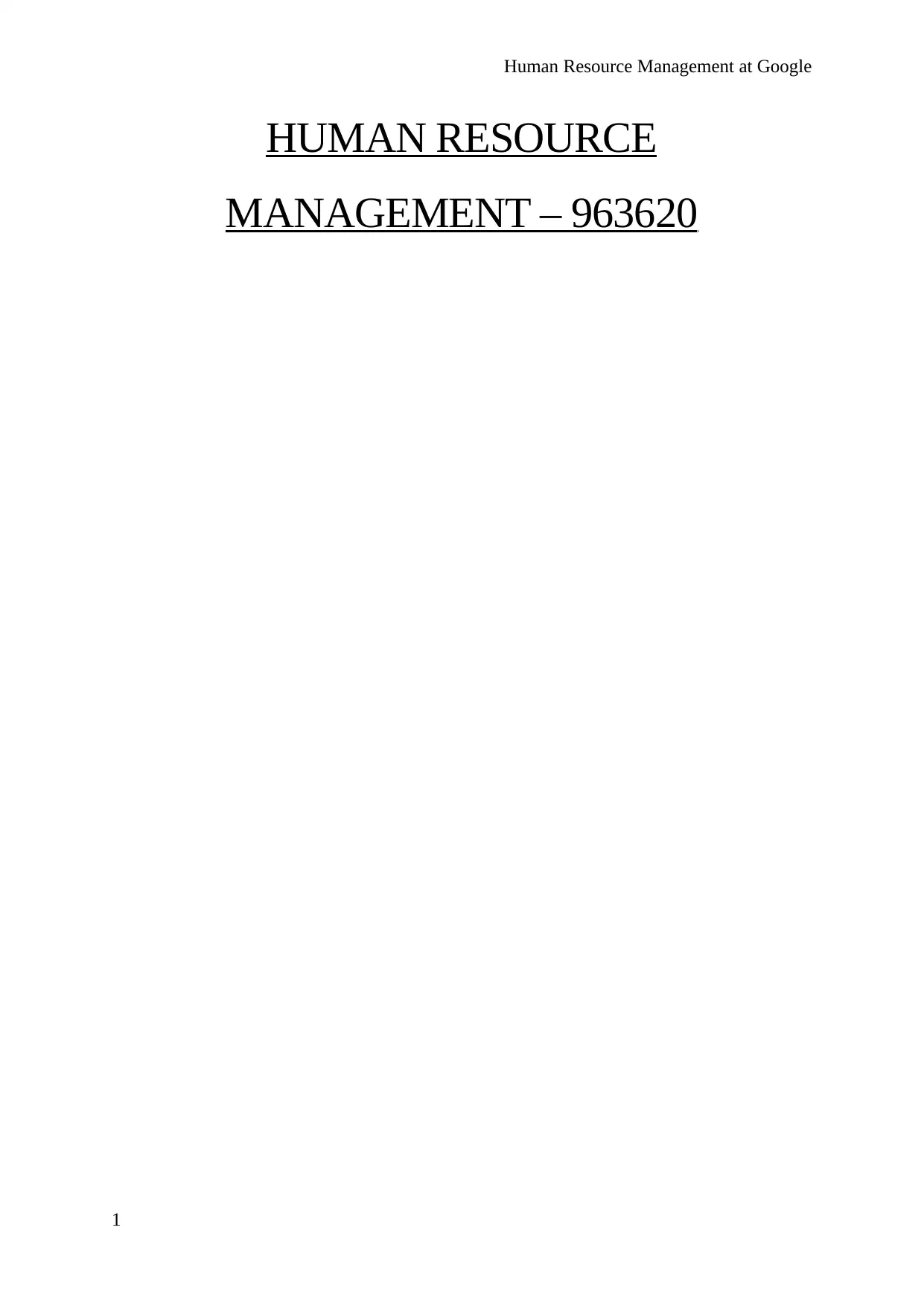
Human Resource Management at Google
HUMAN RESOURCE
MANAGEMENT – 963620
1
HUMAN RESOURCE
MANAGEMENT – 963620
1
Paraphrase This Document
Need a fresh take? Get an instant paraphrase of this document with our AI Paraphraser
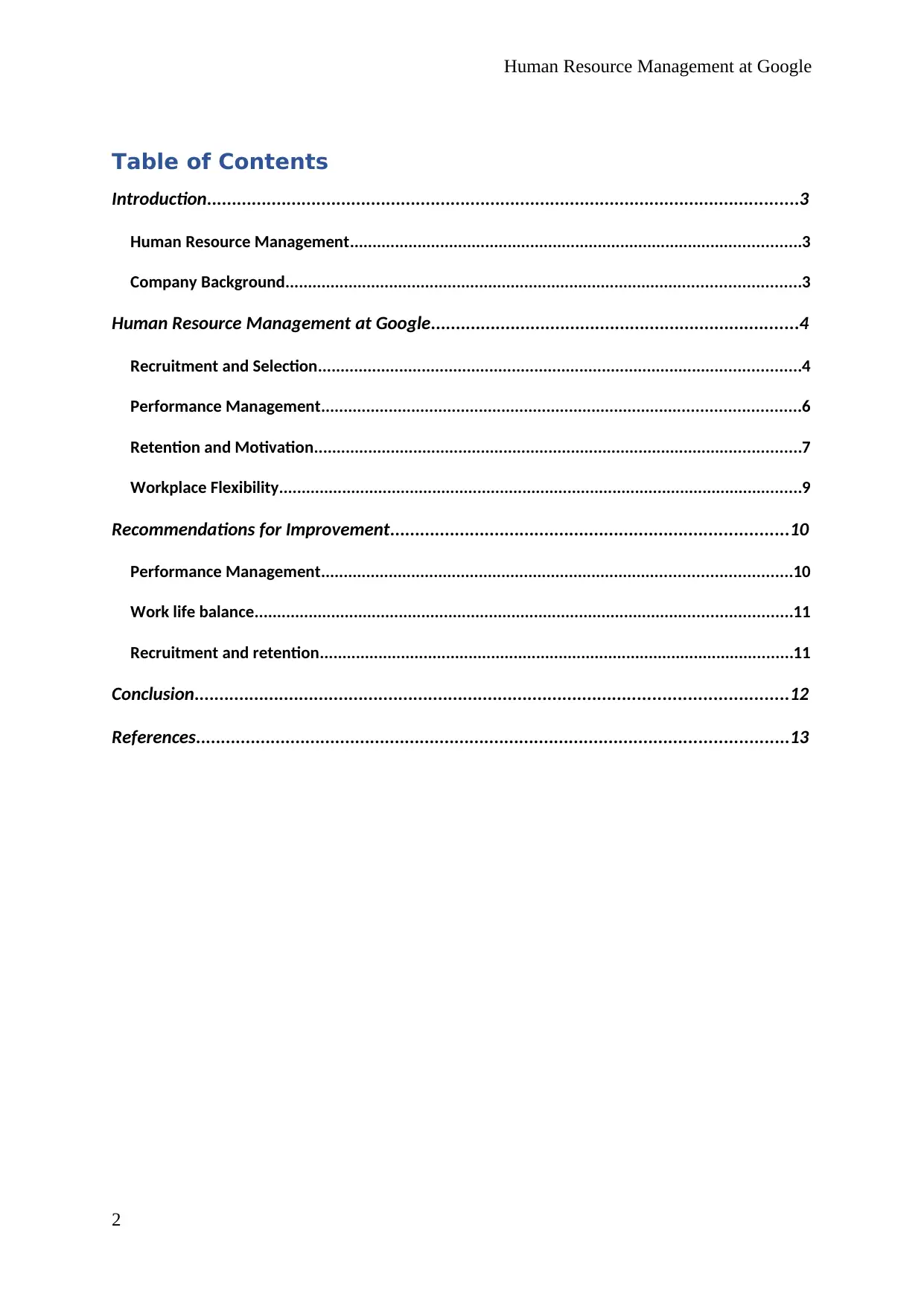
Human Resource Management at Google
Table of Contents
Introduction.......................................................................................................................3
Human Resource Management....................................................................................................3
Company Background..................................................................................................................3
Human Resource Management at Google..........................................................................4
Recruitment and Selection...........................................................................................................4
Performance Management..........................................................................................................6
Retention and Motivation............................................................................................................7
Workplace Flexibility....................................................................................................................9
Recommendations for Improvement................................................................................10
Performance Management........................................................................................................10
Work life balance.......................................................................................................................11
Recruitment and retention.........................................................................................................11
Conclusion.......................................................................................................................12
References.......................................................................................................................13
2
Table of Contents
Introduction.......................................................................................................................3
Human Resource Management....................................................................................................3
Company Background..................................................................................................................3
Human Resource Management at Google..........................................................................4
Recruitment and Selection...........................................................................................................4
Performance Management..........................................................................................................6
Retention and Motivation............................................................................................................7
Workplace Flexibility....................................................................................................................9
Recommendations for Improvement................................................................................10
Performance Management........................................................................................................10
Work life balance.......................................................................................................................11
Recruitment and retention.........................................................................................................11
Conclusion.......................................................................................................................12
References.......................................................................................................................13
2
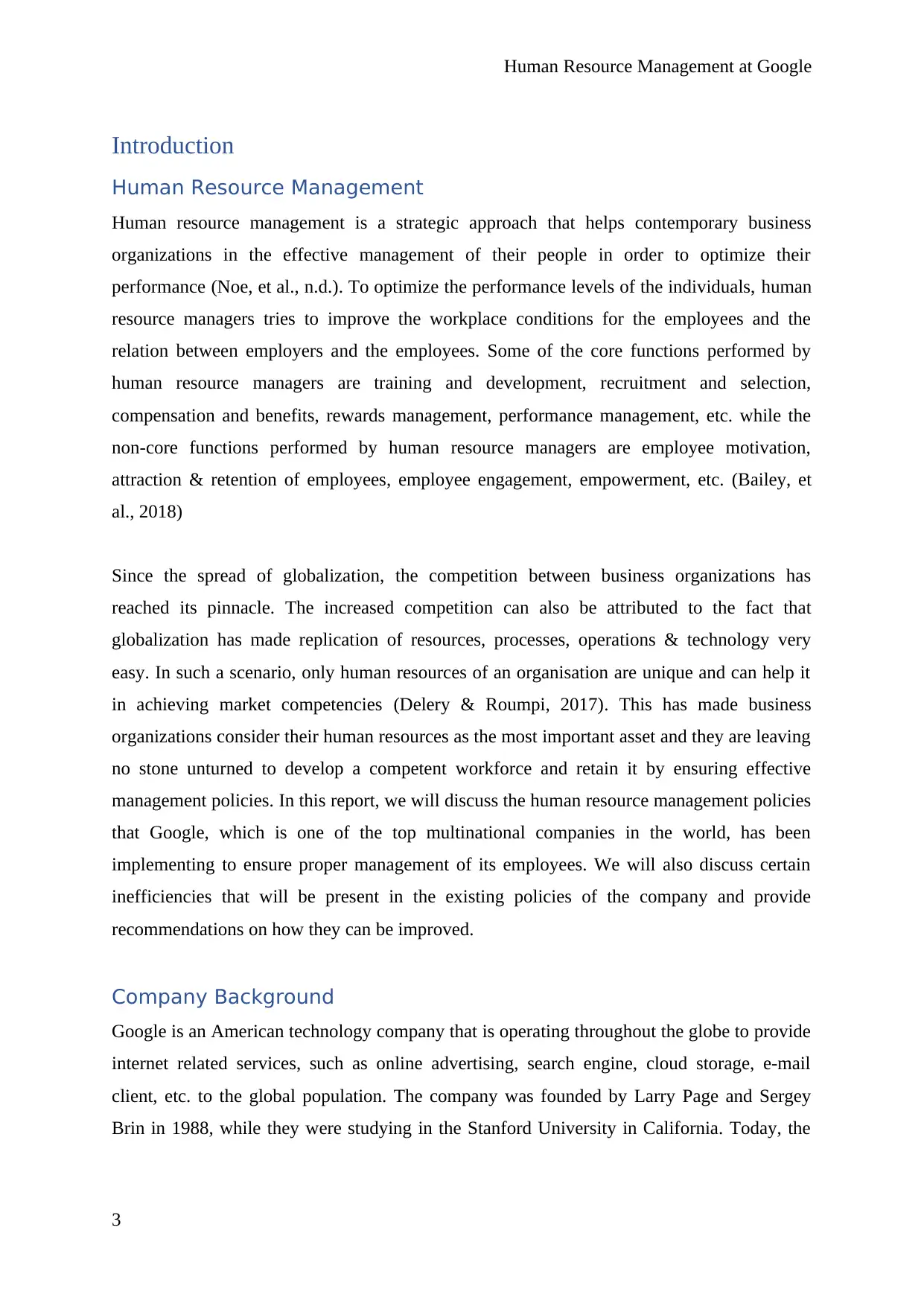
Human Resource Management at Google
Introduction
Human Resource Management
Human resource management is a strategic approach that helps contemporary business
organizations in the effective management of their people in order to optimize their
performance (Noe, et al., n.d.). To optimize the performance levels of the individuals, human
resource managers tries to improve the workplace conditions for the employees and the
relation between employers and the employees. Some of the core functions performed by
human resource managers are training and development, recruitment and selection,
compensation and benefits, rewards management, performance management, etc. while the
non-core functions performed by human resource managers are employee motivation,
attraction & retention of employees, employee engagement, empowerment, etc. (Bailey, et
al., 2018)
Since the spread of globalization, the competition between business organizations has
reached its pinnacle. The increased competition can also be attributed to the fact that
globalization has made replication of resources, processes, operations & technology very
easy. In such a scenario, only human resources of an organisation are unique and can help it
in achieving market competencies (Delery & Roumpi, 2017). This has made business
organizations consider their human resources as the most important asset and they are leaving
no stone unturned to develop a competent workforce and retain it by ensuring effective
management policies. In this report, we will discuss the human resource management policies
that Google, which is one of the top multinational companies in the world, has been
implementing to ensure proper management of its employees. We will also discuss certain
inefficiencies that will be present in the existing policies of the company and provide
recommendations on how they can be improved.
Company Background
Google is an American technology company that is operating throughout the globe to provide
internet related services, such as online advertising, search engine, cloud storage, e-mail
client, etc. to the global population. The company was founded by Larry Page and Sergey
Brin in 1988, while they were studying in the Stanford University in California. Today, the
3
Introduction
Human Resource Management
Human resource management is a strategic approach that helps contemporary business
organizations in the effective management of their people in order to optimize their
performance (Noe, et al., n.d.). To optimize the performance levels of the individuals, human
resource managers tries to improve the workplace conditions for the employees and the
relation between employers and the employees. Some of the core functions performed by
human resource managers are training and development, recruitment and selection,
compensation and benefits, rewards management, performance management, etc. while the
non-core functions performed by human resource managers are employee motivation,
attraction & retention of employees, employee engagement, empowerment, etc. (Bailey, et
al., 2018)
Since the spread of globalization, the competition between business organizations has
reached its pinnacle. The increased competition can also be attributed to the fact that
globalization has made replication of resources, processes, operations & technology very
easy. In such a scenario, only human resources of an organisation are unique and can help it
in achieving market competencies (Delery & Roumpi, 2017). This has made business
organizations consider their human resources as the most important asset and they are leaving
no stone unturned to develop a competent workforce and retain it by ensuring effective
management policies. In this report, we will discuss the human resource management policies
that Google, which is one of the top multinational companies in the world, has been
implementing to ensure proper management of its employees. We will also discuss certain
inefficiencies that will be present in the existing policies of the company and provide
recommendations on how they can be improved.
Company Background
Google is an American technology company that is operating throughout the globe to provide
internet related services, such as online advertising, search engine, cloud storage, e-mail
client, etc. to the global population. The company was founded by Larry Page and Sergey
Brin in 1988, while they were studying in the Stanford University in California. Today, the
3
⊘ This is a preview!⊘
Do you want full access?
Subscribe today to unlock all pages.

Trusted by 1+ million students worldwide
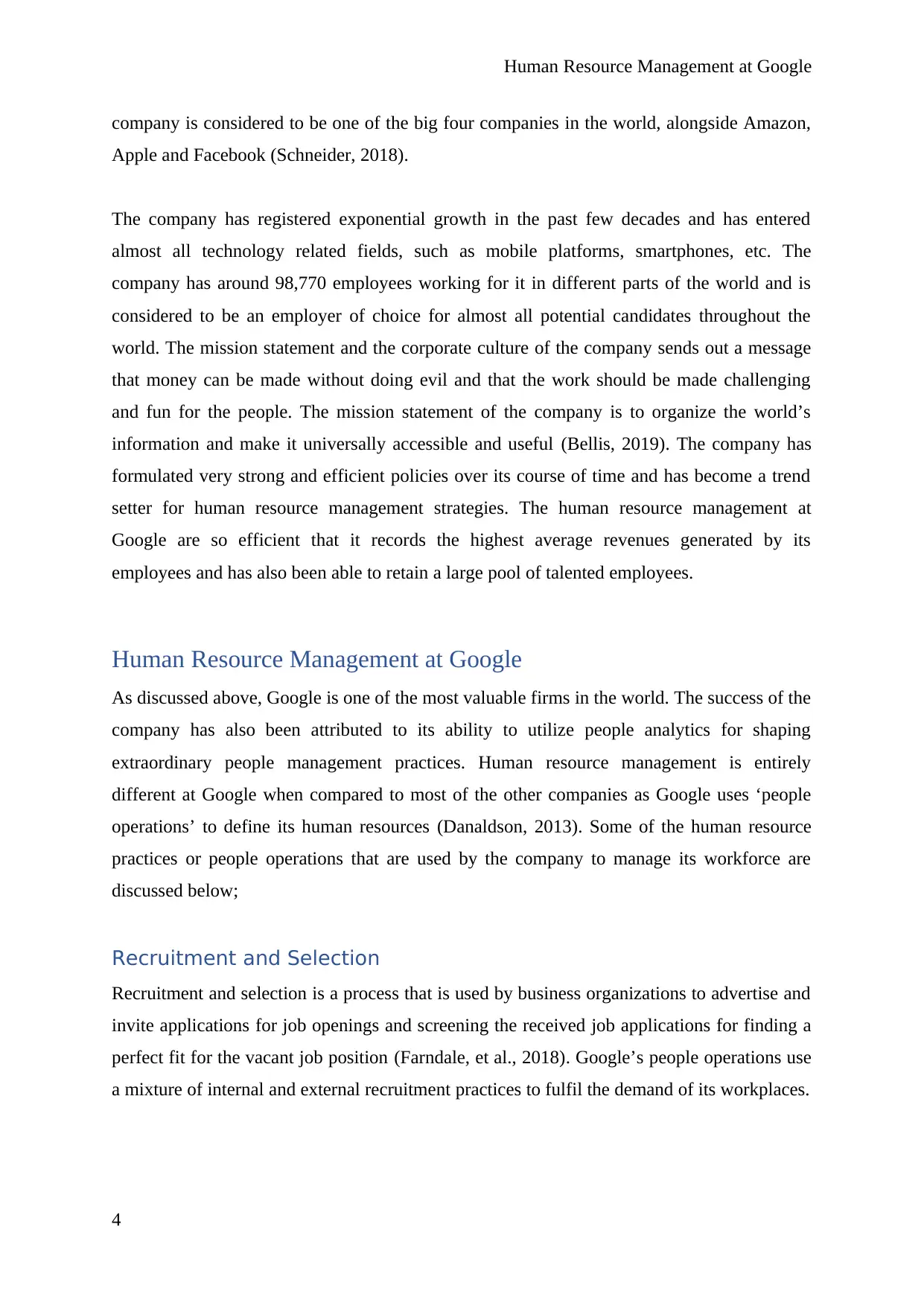
Human Resource Management at Google
company is considered to be one of the big four companies in the world, alongside Amazon,
Apple and Facebook (Schneider, 2018).
The company has registered exponential growth in the past few decades and has entered
almost all technology related fields, such as mobile platforms, smartphones, etc. The
company has around 98,770 employees working for it in different parts of the world and is
considered to be an employer of choice for almost all potential candidates throughout the
world. The mission statement and the corporate culture of the company sends out a message
that money can be made without doing evil and that the work should be made challenging
and fun for the people. The mission statement of the company is to organize the world’s
information and make it universally accessible and useful (Bellis, 2019). The company has
formulated very strong and efficient policies over its course of time and has become a trend
setter for human resource management strategies. The human resource management at
Google are so efficient that it records the highest average revenues generated by its
employees and has also been able to retain a large pool of talented employees.
Human Resource Management at Google
As discussed above, Google is one of the most valuable firms in the world. The success of the
company has also been attributed to its ability to utilize people analytics for shaping
extraordinary people management practices. Human resource management is entirely
different at Google when compared to most of the other companies as Google uses ‘people
operations’ to define its human resources (Danaldson, 2013). Some of the human resource
practices or people operations that are used by the company to manage its workforce are
discussed below;
Recruitment and Selection
Recruitment and selection is a process that is used by business organizations to advertise and
invite applications for job openings and screening the received job applications for finding a
perfect fit for the vacant job position (Farndale, et al., 2018). Google’s people operations use
a mixture of internal and external recruitment practices to fulfil the demand of its workplaces.
4
company is considered to be one of the big four companies in the world, alongside Amazon,
Apple and Facebook (Schneider, 2018).
The company has registered exponential growth in the past few decades and has entered
almost all technology related fields, such as mobile platforms, smartphones, etc. The
company has around 98,770 employees working for it in different parts of the world and is
considered to be an employer of choice for almost all potential candidates throughout the
world. The mission statement and the corporate culture of the company sends out a message
that money can be made without doing evil and that the work should be made challenging
and fun for the people. The mission statement of the company is to organize the world’s
information and make it universally accessible and useful (Bellis, 2019). The company has
formulated very strong and efficient policies over its course of time and has become a trend
setter for human resource management strategies. The human resource management at
Google are so efficient that it records the highest average revenues generated by its
employees and has also been able to retain a large pool of talented employees.
Human Resource Management at Google
As discussed above, Google is one of the most valuable firms in the world. The success of the
company has also been attributed to its ability to utilize people analytics for shaping
extraordinary people management practices. Human resource management is entirely
different at Google when compared to most of the other companies as Google uses ‘people
operations’ to define its human resources (Danaldson, 2013). Some of the human resource
practices or people operations that are used by the company to manage its workforce are
discussed below;
Recruitment and Selection
Recruitment and selection is a process that is used by business organizations to advertise and
invite applications for job openings and screening the received job applications for finding a
perfect fit for the vacant job position (Farndale, et al., 2018). Google’s people operations use
a mixture of internal and external recruitment practices to fulfil the demand of its workplaces.
4
Paraphrase This Document
Need a fresh take? Get an instant paraphrase of this document with our AI Paraphraser
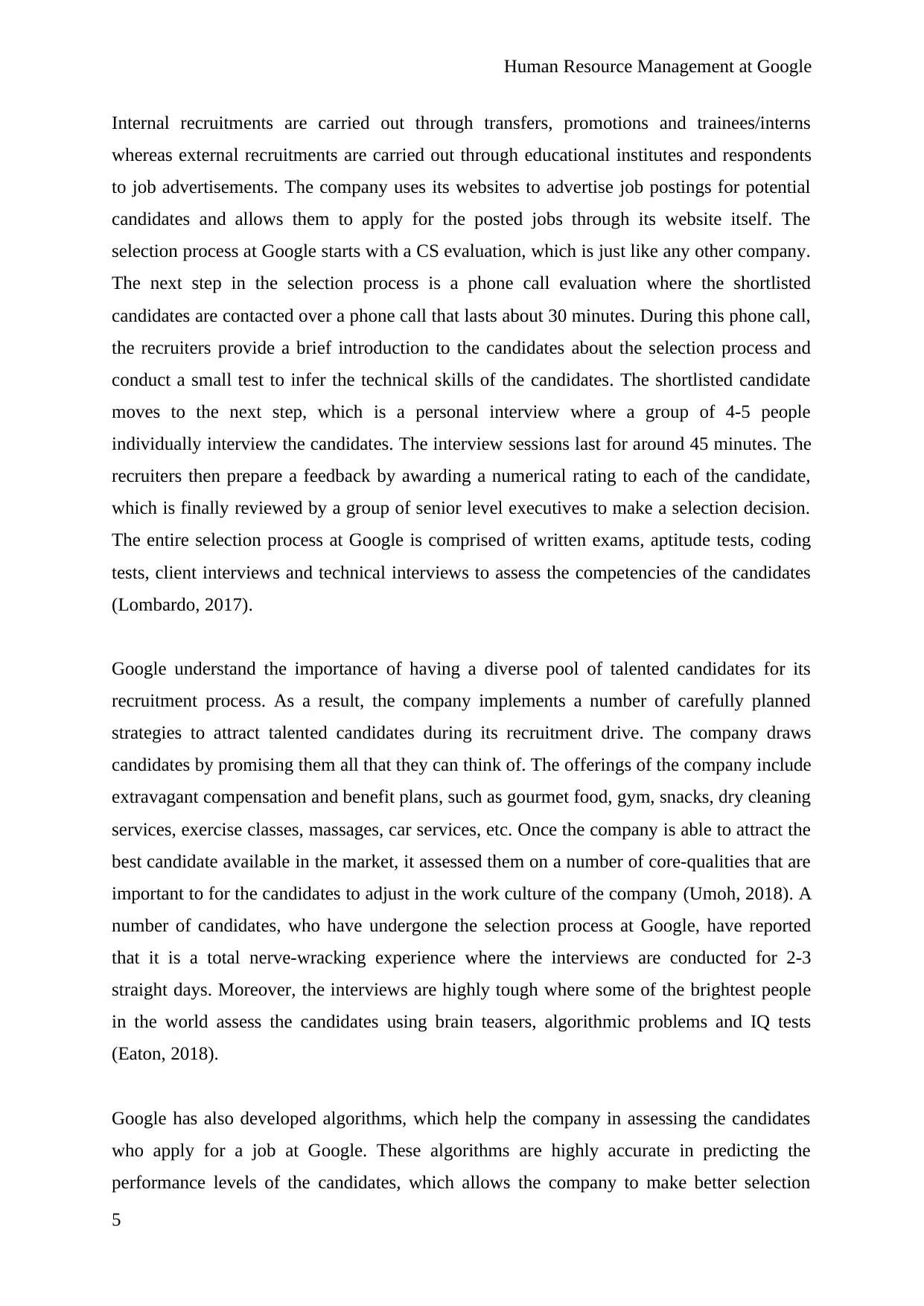
Human Resource Management at Google
Internal recruitments are carried out through transfers, promotions and trainees/interns
whereas external recruitments are carried out through educational institutes and respondents
to job advertisements. The company uses its websites to advertise job postings for potential
candidates and allows them to apply for the posted jobs through its website itself. The
selection process at Google starts with a CS evaluation, which is just like any other company.
The next step in the selection process is a phone call evaluation where the shortlisted
candidates are contacted over a phone call that lasts about 30 minutes. During this phone call,
the recruiters provide a brief introduction to the candidates about the selection process and
conduct a small test to infer the technical skills of the candidates. The shortlisted candidate
moves to the next step, which is a personal interview where a group of 4-5 people
individually interview the candidates. The interview sessions last for around 45 minutes. The
recruiters then prepare a feedback by awarding a numerical rating to each of the candidate,
which is finally reviewed by a group of senior level executives to make a selection decision.
The entire selection process at Google is comprised of written exams, aptitude tests, coding
tests, client interviews and technical interviews to assess the competencies of the candidates
(Lombardo, 2017).
Google understand the importance of having a diverse pool of talented candidates for its
recruitment process. As a result, the company implements a number of carefully planned
strategies to attract talented candidates during its recruitment drive. The company draws
candidates by promising them all that they can think of. The offerings of the company include
extravagant compensation and benefit plans, such as gourmet food, gym, snacks, dry cleaning
services, exercise classes, massages, car services, etc. Once the company is able to attract the
best candidate available in the market, it assessed them on a number of core-qualities that are
important to for the candidates to adjust in the work culture of the company (Umoh, 2018). A
number of candidates, who have undergone the selection process at Google, have reported
that it is a total nerve-wracking experience where the interviews are conducted for 2-3
straight days. Moreover, the interviews are highly tough where some of the brightest people
in the world assess the candidates using brain teasers, algorithmic problems and IQ tests
(Eaton, 2018).
Google has also developed algorithms, which help the company in assessing the candidates
who apply for a job at Google. These algorithms are highly accurate in predicting the
performance levels of the candidates, which allows the company to make better selection
5
Internal recruitments are carried out through transfers, promotions and trainees/interns
whereas external recruitments are carried out through educational institutes and respondents
to job advertisements. The company uses its websites to advertise job postings for potential
candidates and allows them to apply for the posted jobs through its website itself. The
selection process at Google starts with a CS evaluation, which is just like any other company.
The next step in the selection process is a phone call evaluation where the shortlisted
candidates are contacted over a phone call that lasts about 30 minutes. During this phone call,
the recruiters provide a brief introduction to the candidates about the selection process and
conduct a small test to infer the technical skills of the candidates. The shortlisted candidate
moves to the next step, which is a personal interview where a group of 4-5 people
individually interview the candidates. The interview sessions last for around 45 minutes. The
recruiters then prepare a feedback by awarding a numerical rating to each of the candidate,
which is finally reviewed by a group of senior level executives to make a selection decision.
The entire selection process at Google is comprised of written exams, aptitude tests, coding
tests, client interviews and technical interviews to assess the competencies of the candidates
(Lombardo, 2017).
Google understand the importance of having a diverse pool of talented candidates for its
recruitment process. As a result, the company implements a number of carefully planned
strategies to attract talented candidates during its recruitment drive. The company draws
candidates by promising them all that they can think of. The offerings of the company include
extravagant compensation and benefit plans, such as gourmet food, gym, snacks, dry cleaning
services, exercise classes, massages, car services, etc. Once the company is able to attract the
best candidate available in the market, it assessed them on a number of core-qualities that are
important to for the candidates to adjust in the work culture of the company (Umoh, 2018). A
number of candidates, who have undergone the selection process at Google, have reported
that it is a total nerve-wracking experience where the interviews are conducted for 2-3
straight days. Moreover, the interviews are highly tough where some of the brightest people
in the world assess the candidates using brain teasers, algorithmic problems and IQ tests
(Eaton, 2018).
Google has also developed algorithms, which help the company in assessing the candidates
who apply for a job at Google. These algorithms are highly accurate in predicting the
performance levels of the candidates, which allows the company to make better selection
5
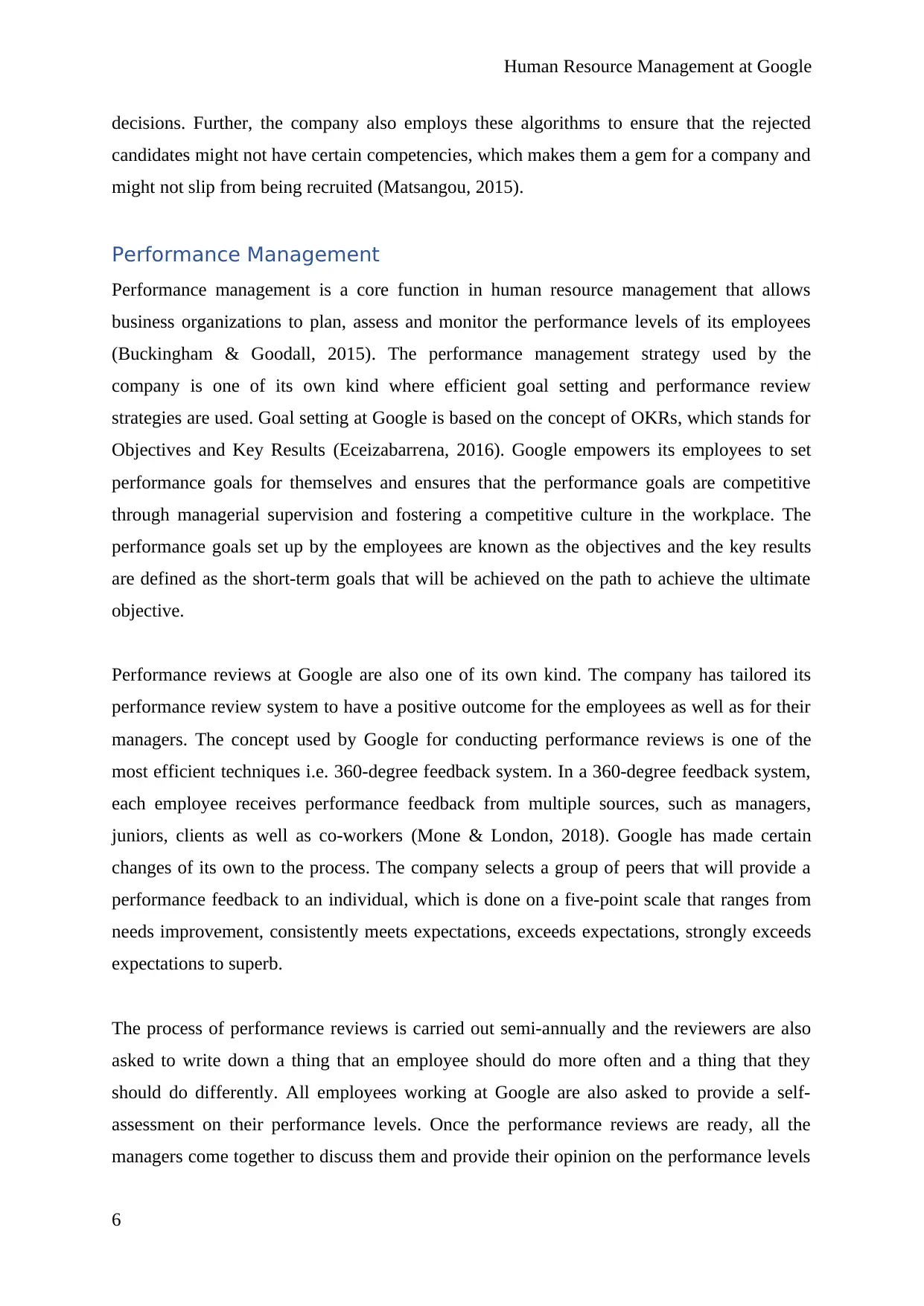
Human Resource Management at Google
decisions. Further, the company also employs these algorithms to ensure that the rejected
candidates might not have certain competencies, which makes them a gem for a company and
might not slip from being recruited (Matsangou, 2015).
Performance Management
Performance management is a core function in human resource management that allows
business organizations to plan, assess and monitor the performance levels of its employees
(Buckingham & Goodall, 2015). The performance management strategy used by the
company is one of its own kind where efficient goal setting and performance review
strategies are used. Goal setting at Google is based on the concept of OKRs, which stands for
Objectives and Key Results (Eceizabarrena, 2016). Google empowers its employees to set
performance goals for themselves and ensures that the performance goals are competitive
through managerial supervision and fostering a competitive culture in the workplace. The
performance goals set up by the employees are known as the objectives and the key results
are defined as the short-term goals that will be achieved on the path to achieve the ultimate
objective.
Performance reviews at Google are also one of its own kind. The company has tailored its
performance review system to have a positive outcome for the employees as well as for their
managers. The concept used by Google for conducting performance reviews is one of the
most efficient techniques i.e. 360-degree feedback system. In a 360-degree feedback system,
each employee receives performance feedback from multiple sources, such as managers,
juniors, clients as well as co-workers (Mone & London, 2018). Google has made certain
changes of its own to the process. The company selects a group of peers that will provide a
performance feedback to an individual, which is done on a five-point scale that ranges from
needs improvement, consistently meets expectations, exceeds expectations, strongly exceeds
expectations to superb.
The process of performance reviews is carried out semi-annually and the reviewers are also
asked to write down a thing that an employee should do more often and a thing that they
should do differently. All employees working at Google are also asked to provide a self-
assessment on their performance levels. Once the performance reviews are ready, all the
managers come together to discuss them and provide their opinion on the performance levels
6
decisions. Further, the company also employs these algorithms to ensure that the rejected
candidates might not have certain competencies, which makes them a gem for a company and
might not slip from being recruited (Matsangou, 2015).
Performance Management
Performance management is a core function in human resource management that allows
business organizations to plan, assess and monitor the performance levels of its employees
(Buckingham & Goodall, 2015). The performance management strategy used by the
company is one of its own kind where efficient goal setting and performance review
strategies are used. Goal setting at Google is based on the concept of OKRs, which stands for
Objectives and Key Results (Eceizabarrena, 2016). Google empowers its employees to set
performance goals for themselves and ensures that the performance goals are competitive
through managerial supervision and fostering a competitive culture in the workplace. The
performance goals set up by the employees are known as the objectives and the key results
are defined as the short-term goals that will be achieved on the path to achieve the ultimate
objective.
Performance reviews at Google are also one of its own kind. The company has tailored its
performance review system to have a positive outcome for the employees as well as for their
managers. The concept used by Google for conducting performance reviews is one of the
most efficient techniques i.e. 360-degree feedback system. In a 360-degree feedback system,
each employee receives performance feedback from multiple sources, such as managers,
juniors, clients as well as co-workers (Mone & London, 2018). Google has made certain
changes of its own to the process. The company selects a group of peers that will provide a
performance feedback to an individual, which is done on a five-point scale that ranges from
needs improvement, consistently meets expectations, exceeds expectations, strongly exceeds
expectations to superb.
The process of performance reviews is carried out semi-annually and the reviewers are also
asked to write down a thing that an employee should do more often and a thing that they
should do differently. All employees working at Google are also asked to provide a self-
assessment on their performance levels. Once the performance reviews are ready, all the
managers come together to discuss them and provide their opinion on the performance levels
6
⊘ This is a preview!⊘
Do you want full access?
Subscribe today to unlock all pages.

Trusted by 1+ million students worldwide
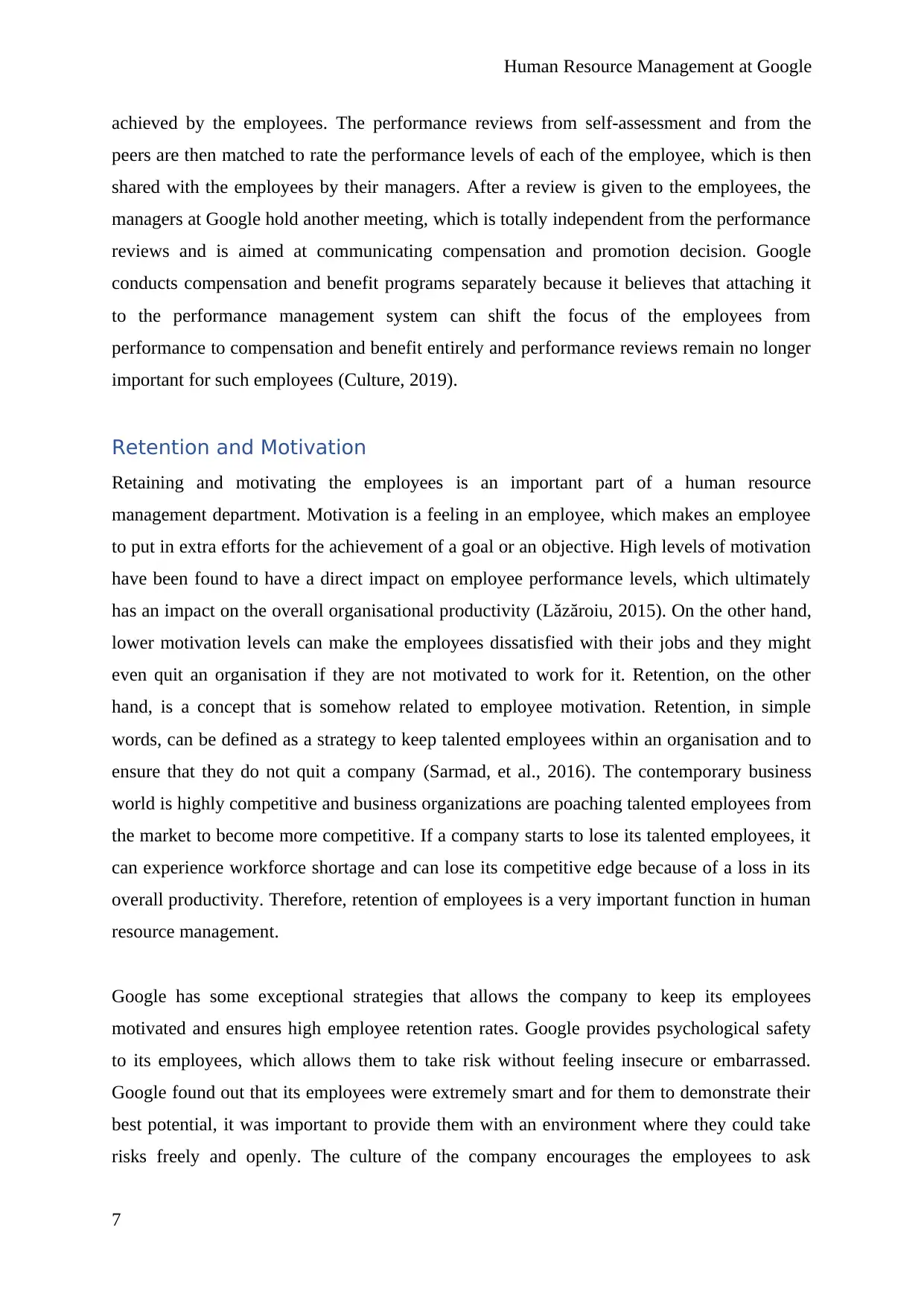
Human Resource Management at Google
achieved by the employees. The performance reviews from self-assessment and from the
peers are then matched to rate the performance levels of each of the employee, which is then
shared with the employees by their managers. After a review is given to the employees, the
managers at Google hold another meeting, which is totally independent from the performance
reviews and is aimed at communicating compensation and promotion decision. Google
conducts compensation and benefit programs separately because it believes that attaching it
to the performance management system can shift the focus of the employees from
performance to compensation and benefit entirely and performance reviews remain no longer
important for such employees (Culture, 2019).
Retention and Motivation
Retaining and motivating the employees is an important part of a human resource
management department. Motivation is a feeling in an employee, which makes an employee
to put in extra efforts for the achievement of a goal or an objective. High levels of motivation
have been found to have a direct impact on employee performance levels, which ultimately
has an impact on the overall organisational productivity (Lăzăroiu, 2015). On the other hand,
lower motivation levels can make the employees dissatisfied with their jobs and they might
even quit an organisation if they are not motivated to work for it. Retention, on the other
hand, is a concept that is somehow related to employee motivation. Retention, in simple
words, can be defined as a strategy to keep talented employees within an organisation and to
ensure that they do not quit a company (Sarmad, et al., 2016). The contemporary business
world is highly competitive and business organizations are poaching talented employees from
the market to become more competitive. If a company starts to lose its talented employees, it
can experience workforce shortage and can lose its competitive edge because of a loss in its
overall productivity. Therefore, retention of employees is a very important function in human
resource management.
Google has some exceptional strategies that allows the company to keep its employees
motivated and ensures high employee retention rates. Google provides psychological safety
to its employees, which allows them to take risk without feeling insecure or embarrassed.
Google found out that its employees were extremely smart and for them to demonstrate their
best potential, it was important to provide them with an environment where they could take
risks freely and openly. The culture of the company encourages the employees to ask
7
achieved by the employees. The performance reviews from self-assessment and from the
peers are then matched to rate the performance levels of each of the employee, which is then
shared with the employees by their managers. After a review is given to the employees, the
managers at Google hold another meeting, which is totally independent from the performance
reviews and is aimed at communicating compensation and promotion decision. Google
conducts compensation and benefit programs separately because it believes that attaching it
to the performance management system can shift the focus of the employees from
performance to compensation and benefit entirely and performance reviews remain no longer
important for such employees (Culture, 2019).
Retention and Motivation
Retaining and motivating the employees is an important part of a human resource
management department. Motivation is a feeling in an employee, which makes an employee
to put in extra efforts for the achievement of a goal or an objective. High levels of motivation
have been found to have a direct impact on employee performance levels, which ultimately
has an impact on the overall organisational productivity (Lăzăroiu, 2015). On the other hand,
lower motivation levels can make the employees dissatisfied with their jobs and they might
even quit an organisation if they are not motivated to work for it. Retention, on the other
hand, is a concept that is somehow related to employee motivation. Retention, in simple
words, can be defined as a strategy to keep talented employees within an organisation and to
ensure that they do not quit a company (Sarmad, et al., 2016). The contemporary business
world is highly competitive and business organizations are poaching talented employees from
the market to become more competitive. If a company starts to lose its talented employees, it
can experience workforce shortage and can lose its competitive edge because of a loss in its
overall productivity. Therefore, retention of employees is a very important function in human
resource management.
Google has some exceptional strategies that allows the company to keep its employees
motivated and ensures high employee retention rates. Google provides psychological safety
to its employees, which allows them to take risk without feeling insecure or embarrassed.
Google found out that its employees were extremely smart and for them to demonstrate their
best potential, it was important to provide them with an environment where they could take
risks freely and openly. The culture of the company encourages the employees to ask
7
Paraphrase This Document
Need a fresh take? Get an instant paraphrase of this document with our AI Paraphraser
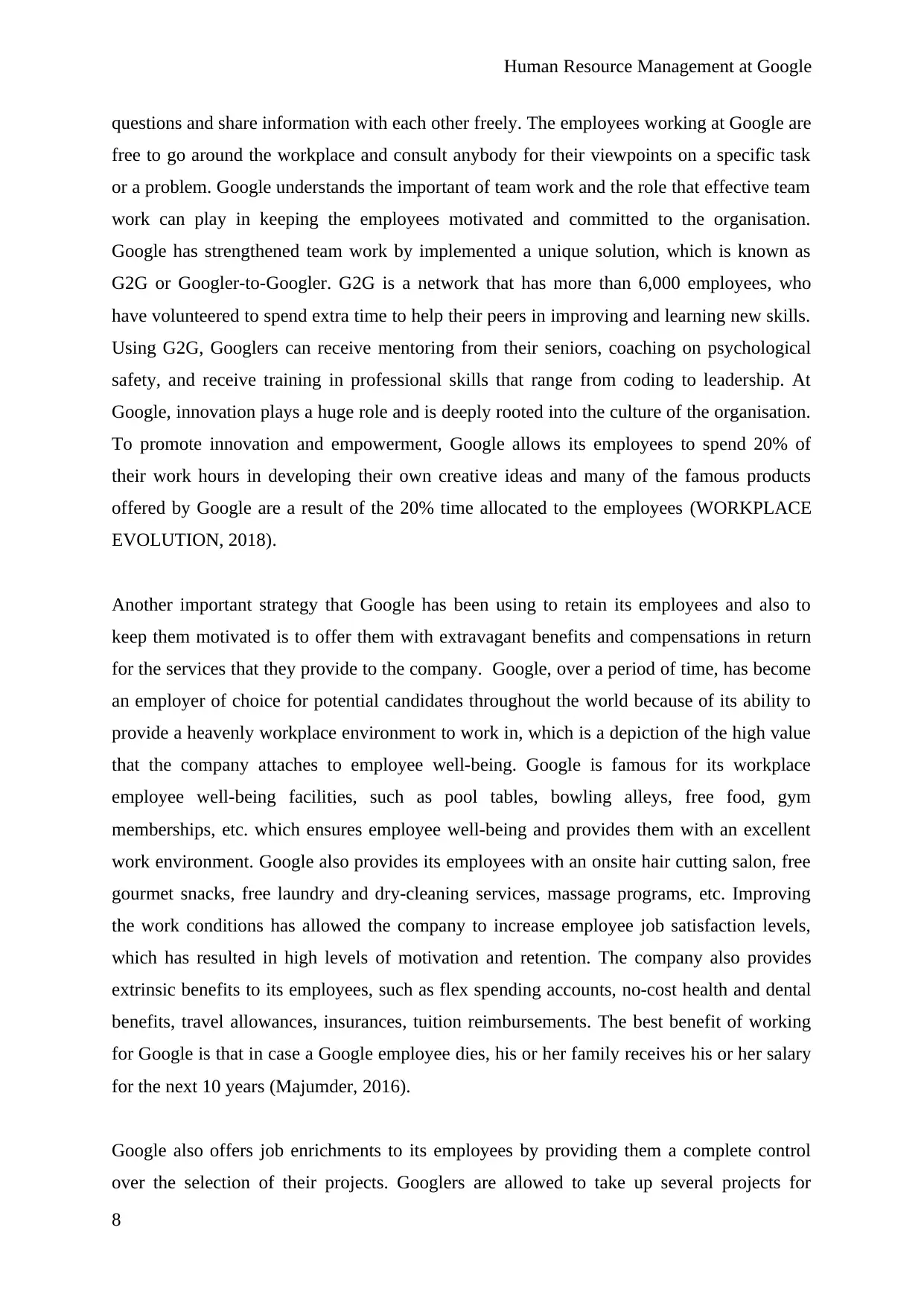
Human Resource Management at Google
questions and share information with each other freely. The employees working at Google are
free to go around the workplace and consult anybody for their viewpoints on a specific task
or a problem. Google understands the important of team work and the role that effective team
work can play in keeping the employees motivated and committed to the organisation.
Google has strengthened team work by implemented a unique solution, which is known as
G2G or Googler-to-Googler. G2G is a network that has more than 6,000 employees, who
have volunteered to spend extra time to help their peers in improving and learning new skills.
Using G2G, Googlers can receive mentoring from their seniors, coaching on psychological
safety, and receive training in professional skills that range from coding to leadership. At
Google, innovation plays a huge role and is deeply rooted into the culture of the organisation.
To promote innovation and empowerment, Google allows its employees to spend 20% of
their work hours in developing their own creative ideas and many of the famous products
offered by Google are a result of the 20% time allocated to the employees (WORKPLACE
EVOLUTION, 2018).
Another important strategy that Google has been using to retain its employees and also to
keep them motivated is to offer them with extravagant benefits and compensations in return
for the services that they provide to the company. Google, over a period of time, has become
an employer of choice for potential candidates throughout the world because of its ability to
provide a heavenly workplace environment to work in, which is a depiction of the high value
that the company attaches to employee well-being. Google is famous for its workplace
employee well-being facilities, such as pool tables, bowling alleys, free food, gym
memberships, etc. which ensures employee well-being and provides them with an excellent
work environment. Google also provides its employees with an onsite hair cutting salon, free
gourmet snacks, free laundry and dry-cleaning services, massage programs, etc. Improving
the work conditions has allowed the company to increase employee job satisfaction levels,
which has resulted in high levels of motivation and retention. The company also provides
extrinsic benefits to its employees, such as flex spending accounts, no-cost health and dental
benefits, travel allowances, insurances, tuition reimbursements. The best benefit of working
for Google is that in case a Google employee dies, his or her family receives his or her salary
for the next 10 years (Majumder, 2016).
Google also offers job enrichments to its employees by providing them a complete control
over the selection of their projects. Googlers are allowed to take up several projects for
8
questions and share information with each other freely. The employees working at Google are
free to go around the workplace and consult anybody for their viewpoints on a specific task
or a problem. Google understands the important of team work and the role that effective team
work can play in keeping the employees motivated and committed to the organisation.
Google has strengthened team work by implemented a unique solution, which is known as
G2G or Googler-to-Googler. G2G is a network that has more than 6,000 employees, who
have volunteered to spend extra time to help their peers in improving and learning new skills.
Using G2G, Googlers can receive mentoring from their seniors, coaching on psychological
safety, and receive training in professional skills that range from coding to leadership. At
Google, innovation plays a huge role and is deeply rooted into the culture of the organisation.
To promote innovation and empowerment, Google allows its employees to spend 20% of
their work hours in developing their own creative ideas and many of the famous products
offered by Google are a result of the 20% time allocated to the employees (WORKPLACE
EVOLUTION, 2018).
Another important strategy that Google has been using to retain its employees and also to
keep them motivated is to offer them with extravagant benefits and compensations in return
for the services that they provide to the company. Google, over a period of time, has become
an employer of choice for potential candidates throughout the world because of its ability to
provide a heavenly workplace environment to work in, which is a depiction of the high value
that the company attaches to employee well-being. Google is famous for its workplace
employee well-being facilities, such as pool tables, bowling alleys, free food, gym
memberships, etc. which ensures employee well-being and provides them with an excellent
work environment. Google also provides its employees with an onsite hair cutting salon, free
gourmet snacks, free laundry and dry-cleaning services, massage programs, etc. Improving
the work conditions has allowed the company to increase employee job satisfaction levels,
which has resulted in high levels of motivation and retention. The company also provides
extrinsic benefits to its employees, such as flex spending accounts, no-cost health and dental
benefits, travel allowances, insurances, tuition reimbursements. The best benefit of working
for Google is that in case a Google employee dies, his or her family receives his or her salary
for the next 10 years (Majumder, 2016).
Google also offers job enrichments to its employees by providing them a complete control
over the selection of their projects. Googlers are allowed to take up several projects for
8
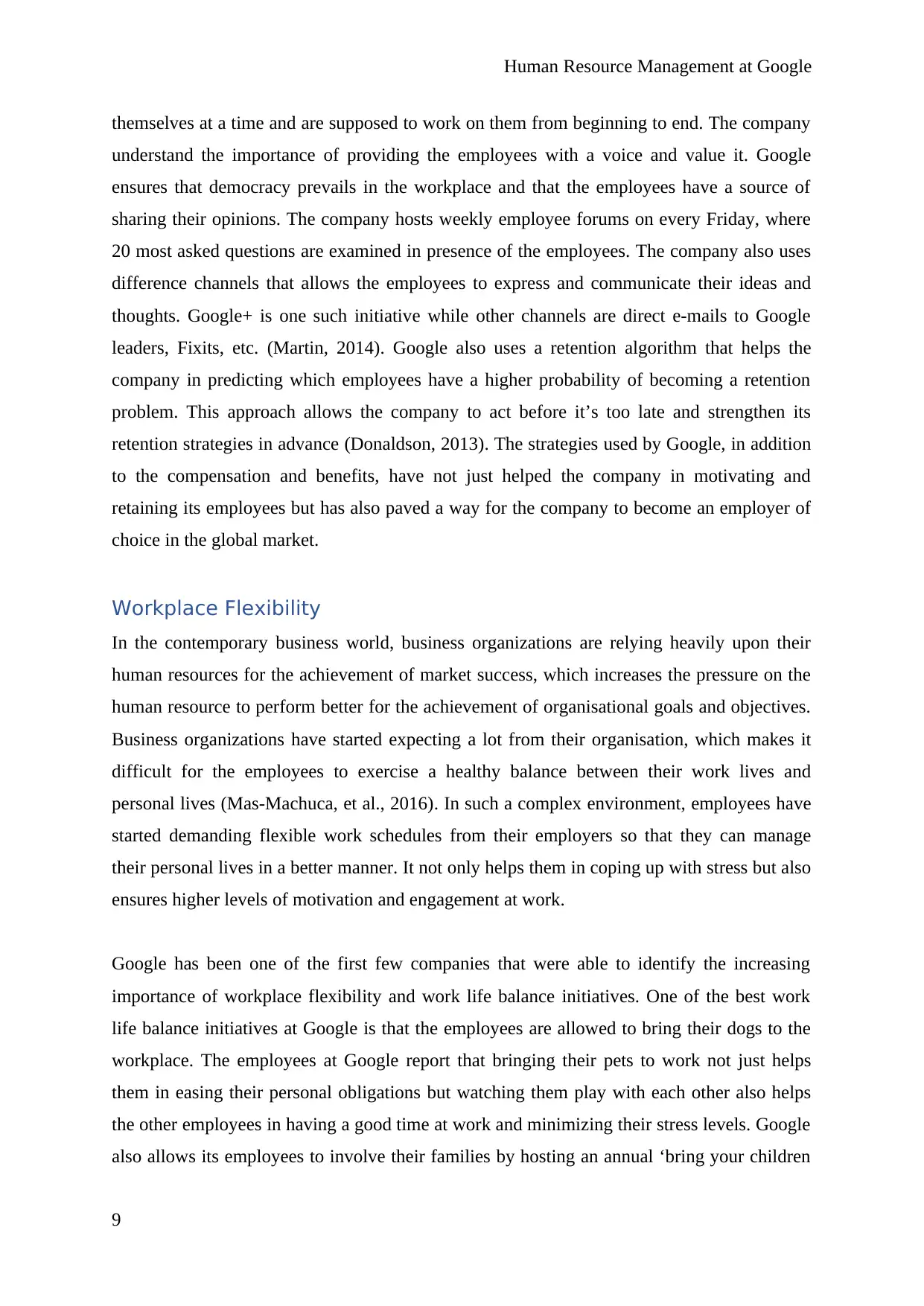
Human Resource Management at Google
themselves at a time and are supposed to work on them from beginning to end. The company
understand the importance of providing the employees with a voice and value it. Google
ensures that democracy prevails in the workplace and that the employees have a source of
sharing their opinions. The company hosts weekly employee forums on every Friday, where
20 most asked questions are examined in presence of the employees. The company also uses
difference channels that allows the employees to express and communicate their ideas and
thoughts. Google+ is one such initiative while other channels are direct e-mails to Google
leaders, Fixits, etc. (Martin, 2014). Google also uses a retention algorithm that helps the
company in predicting which employees have a higher probability of becoming a retention
problem. This approach allows the company to act before it’s too late and strengthen its
retention strategies in advance (Donaldson, 2013). The strategies used by Google, in addition
to the compensation and benefits, have not just helped the company in motivating and
retaining its employees but has also paved a way for the company to become an employer of
choice in the global market.
Workplace Flexibility
In the contemporary business world, business organizations are relying heavily upon their
human resources for the achievement of market success, which increases the pressure on the
human resource to perform better for the achievement of organisational goals and objectives.
Business organizations have started expecting a lot from their organisation, which makes it
difficult for the employees to exercise a healthy balance between their work lives and
personal lives (Mas-Machuca, et al., 2016). In such a complex environment, employees have
started demanding flexible work schedules from their employers so that they can manage
their personal lives in a better manner. It not only helps them in coping up with stress but also
ensures higher levels of motivation and engagement at work.
Google has been one of the first few companies that were able to identify the increasing
importance of workplace flexibility and work life balance initiatives. One of the best work
life balance initiatives at Google is that the employees are allowed to bring their dogs to the
workplace. The employees at Google report that bringing their pets to work not just helps
them in easing their personal obligations but watching them play with each other also helps
the other employees in having a good time at work and minimizing their stress levels. Google
also allows its employees to involve their families by hosting an annual ‘bring your children
9
themselves at a time and are supposed to work on them from beginning to end. The company
understand the importance of providing the employees with a voice and value it. Google
ensures that democracy prevails in the workplace and that the employees have a source of
sharing their opinions. The company hosts weekly employee forums on every Friday, where
20 most asked questions are examined in presence of the employees. The company also uses
difference channels that allows the employees to express and communicate their ideas and
thoughts. Google+ is one such initiative while other channels are direct e-mails to Google
leaders, Fixits, etc. (Martin, 2014). Google also uses a retention algorithm that helps the
company in predicting which employees have a higher probability of becoming a retention
problem. This approach allows the company to act before it’s too late and strengthen its
retention strategies in advance (Donaldson, 2013). The strategies used by Google, in addition
to the compensation and benefits, have not just helped the company in motivating and
retaining its employees but has also paved a way for the company to become an employer of
choice in the global market.
Workplace Flexibility
In the contemporary business world, business organizations are relying heavily upon their
human resources for the achievement of market success, which increases the pressure on the
human resource to perform better for the achievement of organisational goals and objectives.
Business organizations have started expecting a lot from their organisation, which makes it
difficult for the employees to exercise a healthy balance between their work lives and
personal lives (Mas-Machuca, et al., 2016). In such a complex environment, employees have
started demanding flexible work schedules from their employers so that they can manage
their personal lives in a better manner. It not only helps them in coping up with stress but also
ensures higher levels of motivation and engagement at work.
Google has been one of the first few companies that were able to identify the increasing
importance of workplace flexibility and work life balance initiatives. One of the best work
life balance initiatives at Google is that the employees are allowed to bring their dogs to the
workplace. The employees at Google report that bringing their pets to work not just helps
them in easing their personal obligations but watching them play with each other also helps
the other employees in having a good time at work and minimizing their stress levels. Google
also allows its employees to involve their families by hosting an annual ‘bring your children
9
⊘ This is a preview!⊘
Do you want full access?
Subscribe today to unlock all pages.

Trusted by 1+ million students worldwide
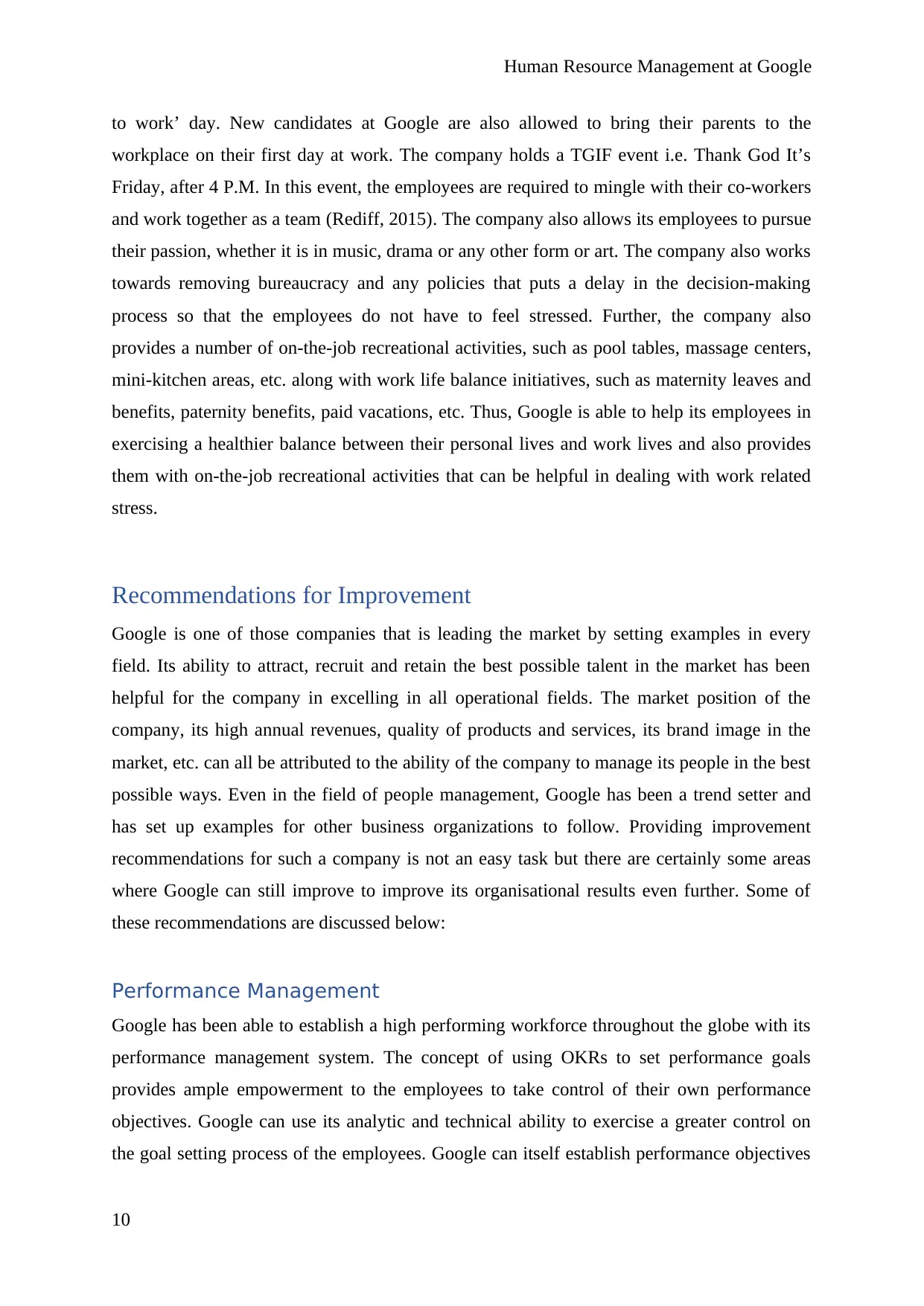
Human Resource Management at Google
to work’ day. New candidates at Google are also allowed to bring their parents to the
workplace on their first day at work. The company holds a TGIF event i.e. Thank God It’s
Friday, after 4 P.M. In this event, the employees are required to mingle with their co-workers
and work together as a team (Rediff, 2015). The company also allows its employees to pursue
their passion, whether it is in music, drama or any other form or art. The company also works
towards removing bureaucracy and any policies that puts a delay in the decision-making
process so that the employees do not have to feel stressed. Further, the company also
provides a number of on-the-job recreational activities, such as pool tables, massage centers,
mini-kitchen areas, etc. along with work life balance initiatives, such as maternity leaves and
benefits, paternity benefits, paid vacations, etc. Thus, Google is able to help its employees in
exercising a healthier balance between their personal lives and work lives and also provides
them with on-the-job recreational activities that can be helpful in dealing with work related
stress.
Recommendations for Improvement
Google is one of those companies that is leading the market by setting examples in every
field. Its ability to attract, recruit and retain the best possible talent in the market has been
helpful for the company in excelling in all operational fields. The market position of the
company, its high annual revenues, quality of products and services, its brand image in the
market, etc. can all be attributed to the ability of the company to manage its people in the best
possible ways. Even in the field of people management, Google has been a trend setter and
has set up examples for other business organizations to follow. Providing improvement
recommendations for such a company is not an easy task but there are certainly some areas
where Google can still improve to improve its organisational results even further. Some of
these recommendations are discussed below:
Performance Management
Google has been able to establish a high performing workforce throughout the globe with its
performance management system. The concept of using OKRs to set performance goals
provides ample empowerment to the employees to take control of their own performance
objectives. Google can use its analytic and technical ability to exercise a greater control on
the goal setting process of the employees. Google can itself establish performance objectives
10
to work’ day. New candidates at Google are also allowed to bring their parents to the
workplace on their first day at work. The company holds a TGIF event i.e. Thank God It’s
Friday, after 4 P.M. In this event, the employees are required to mingle with their co-workers
and work together as a team (Rediff, 2015). The company also allows its employees to pursue
their passion, whether it is in music, drama or any other form or art. The company also works
towards removing bureaucracy and any policies that puts a delay in the decision-making
process so that the employees do not have to feel stressed. Further, the company also
provides a number of on-the-job recreational activities, such as pool tables, massage centers,
mini-kitchen areas, etc. along with work life balance initiatives, such as maternity leaves and
benefits, paternity benefits, paid vacations, etc. Thus, Google is able to help its employees in
exercising a healthier balance between their personal lives and work lives and also provides
them with on-the-job recreational activities that can be helpful in dealing with work related
stress.
Recommendations for Improvement
Google is one of those companies that is leading the market by setting examples in every
field. Its ability to attract, recruit and retain the best possible talent in the market has been
helpful for the company in excelling in all operational fields. The market position of the
company, its high annual revenues, quality of products and services, its brand image in the
market, etc. can all be attributed to the ability of the company to manage its people in the best
possible ways. Even in the field of people management, Google has been a trend setter and
has set up examples for other business organizations to follow. Providing improvement
recommendations for such a company is not an easy task but there are certainly some areas
where Google can still improve to improve its organisational results even further. Some of
these recommendations are discussed below:
Performance Management
Google has been able to establish a high performing workforce throughout the globe with its
performance management system. The concept of using OKRs to set performance goals
provides ample empowerment to the employees to take control of their own performance
objectives. Google can use its analytic and technical ability to exercise a greater control on
the goal setting process of the employees. Google can itself establish performance objectives
10
Paraphrase This Document
Need a fresh take? Get an instant paraphrase of this document with our AI Paraphraser
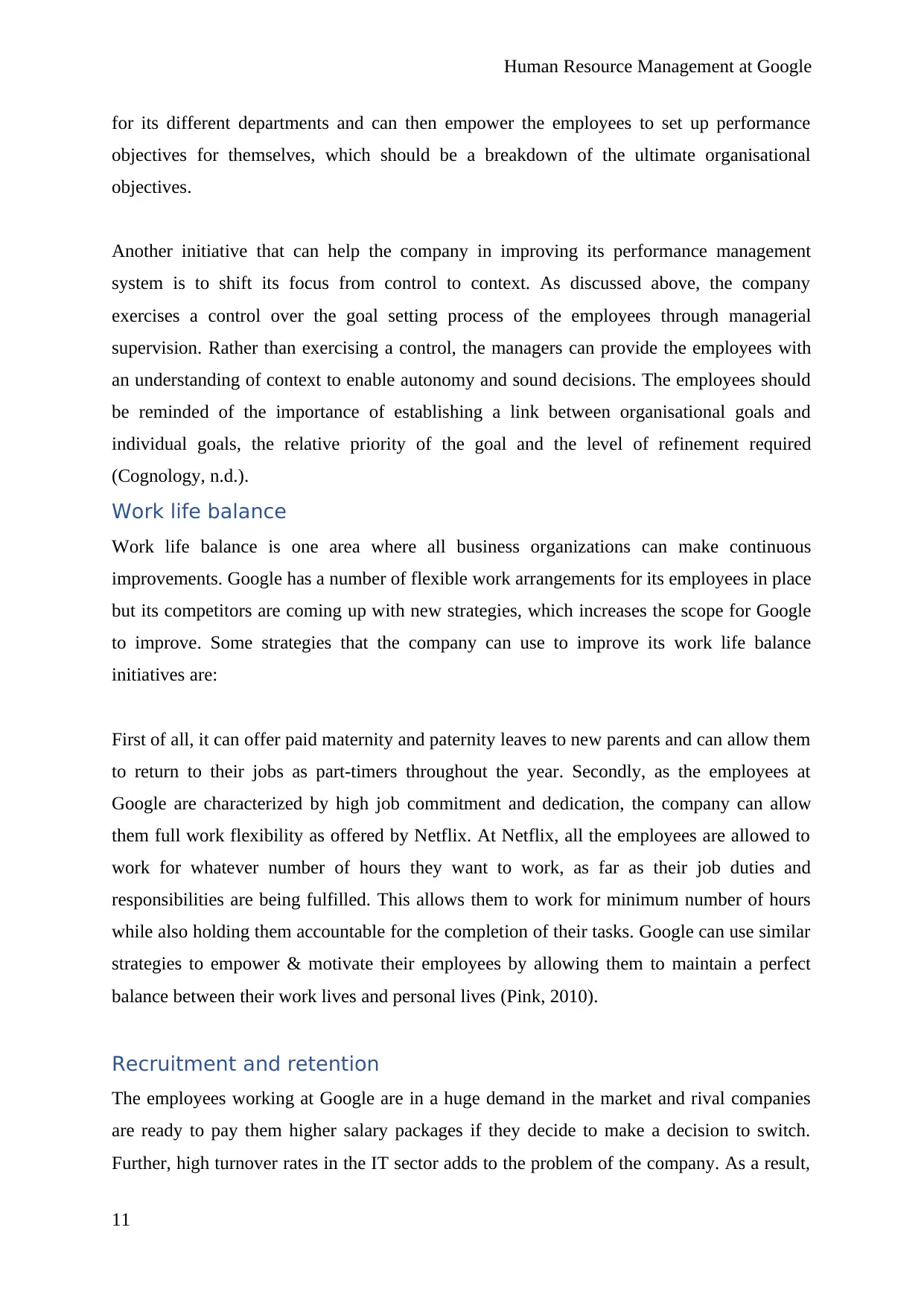
Human Resource Management at Google
for its different departments and can then empower the employees to set up performance
objectives for themselves, which should be a breakdown of the ultimate organisational
objectives.
Another initiative that can help the company in improving its performance management
system is to shift its focus from control to context. As discussed above, the company
exercises a control over the goal setting process of the employees through managerial
supervision. Rather than exercising a control, the managers can provide the employees with
an understanding of context to enable autonomy and sound decisions. The employees should
be reminded of the importance of establishing a link between organisational goals and
individual goals, the relative priority of the goal and the level of refinement required
(Cognology, n.d.).
Work life balance
Work life balance is one area where all business organizations can make continuous
improvements. Google has a number of flexible work arrangements for its employees in place
but its competitors are coming up with new strategies, which increases the scope for Google
to improve. Some strategies that the company can use to improve its work life balance
initiatives are:
First of all, it can offer paid maternity and paternity leaves to new parents and can allow them
to return to their jobs as part-timers throughout the year. Secondly, as the employees at
Google are characterized by high job commitment and dedication, the company can allow
them full work flexibility as offered by Netflix. At Netflix, all the employees are allowed to
work for whatever number of hours they want to work, as far as their job duties and
responsibilities are being fulfilled. This allows them to work for minimum number of hours
while also holding them accountable for the completion of their tasks. Google can use similar
strategies to empower & motivate their employees by allowing them to maintain a perfect
balance between their work lives and personal lives (Pink, 2010).
Recruitment and retention
The employees working at Google are in a huge demand in the market and rival companies
are ready to pay them higher salary packages if they decide to make a decision to switch.
Further, high turnover rates in the IT sector adds to the problem of the company. As a result,
11
for its different departments and can then empower the employees to set up performance
objectives for themselves, which should be a breakdown of the ultimate organisational
objectives.
Another initiative that can help the company in improving its performance management
system is to shift its focus from control to context. As discussed above, the company
exercises a control over the goal setting process of the employees through managerial
supervision. Rather than exercising a control, the managers can provide the employees with
an understanding of context to enable autonomy and sound decisions. The employees should
be reminded of the importance of establishing a link between organisational goals and
individual goals, the relative priority of the goal and the level of refinement required
(Cognology, n.d.).
Work life balance
Work life balance is one area where all business organizations can make continuous
improvements. Google has a number of flexible work arrangements for its employees in place
but its competitors are coming up with new strategies, which increases the scope for Google
to improve. Some strategies that the company can use to improve its work life balance
initiatives are:
First of all, it can offer paid maternity and paternity leaves to new parents and can allow them
to return to their jobs as part-timers throughout the year. Secondly, as the employees at
Google are characterized by high job commitment and dedication, the company can allow
them full work flexibility as offered by Netflix. At Netflix, all the employees are allowed to
work for whatever number of hours they want to work, as far as their job duties and
responsibilities are being fulfilled. This allows them to work for minimum number of hours
while also holding them accountable for the completion of their tasks. Google can use similar
strategies to empower & motivate their employees by allowing them to maintain a perfect
balance between their work lives and personal lives (Pink, 2010).
Recruitment and retention
The employees working at Google are in a huge demand in the market and rival companies
are ready to pay them higher salary packages if they decide to make a decision to switch.
Further, high turnover rates in the IT sector adds to the problem of the company. As a result,
11
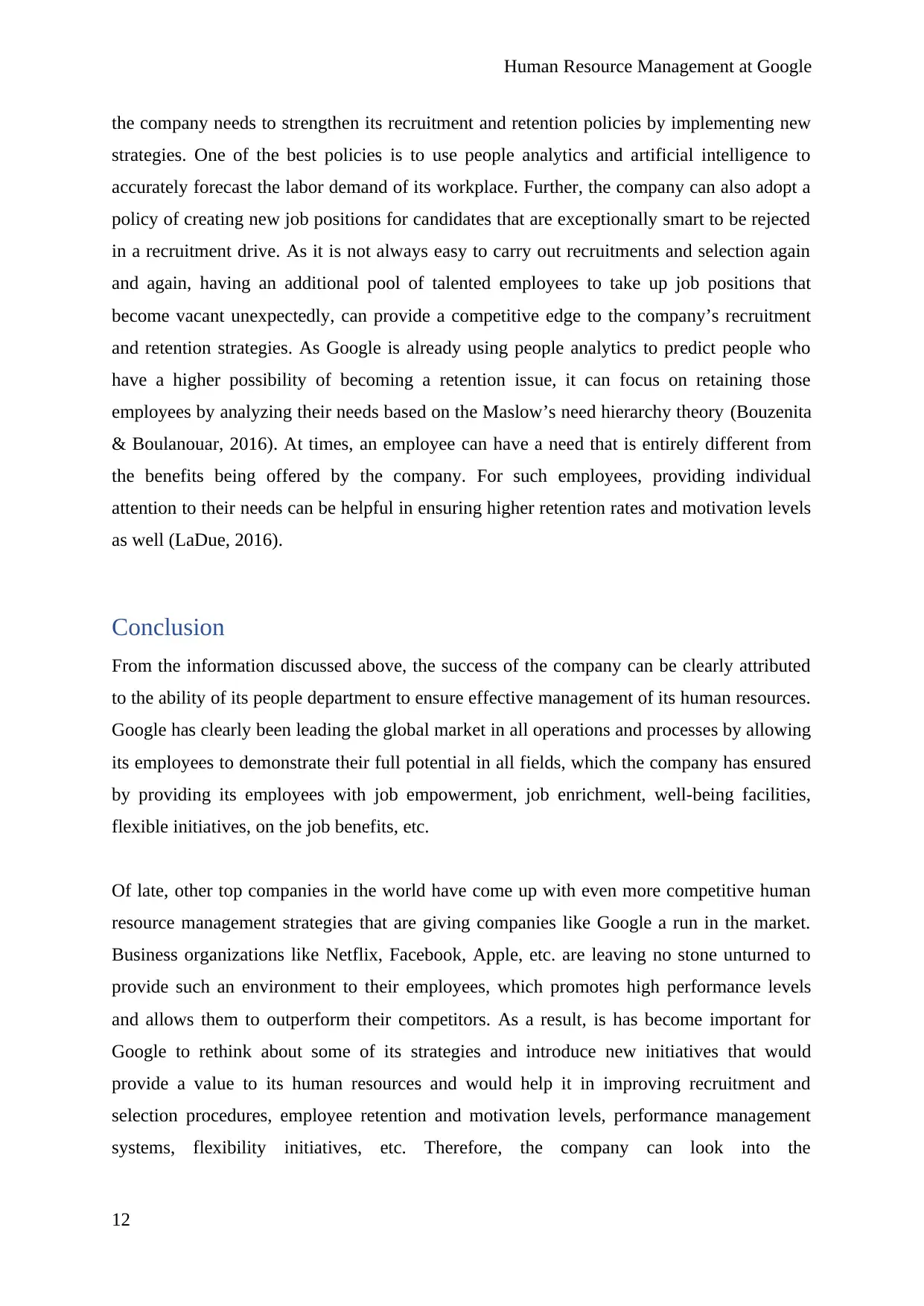
Human Resource Management at Google
the company needs to strengthen its recruitment and retention policies by implementing new
strategies. One of the best policies is to use people analytics and artificial intelligence to
accurately forecast the labor demand of its workplace. Further, the company can also adopt a
policy of creating new job positions for candidates that are exceptionally smart to be rejected
in a recruitment drive. As it is not always easy to carry out recruitments and selection again
and again, having an additional pool of talented employees to take up job positions that
become vacant unexpectedly, can provide a competitive edge to the company’s recruitment
and retention strategies. As Google is already using people analytics to predict people who
have a higher possibility of becoming a retention issue, it can focus on retaining those
employees by analyzing their needs based on the Maslow’s need hierarchy theory (Bouzenita
& Boulanouar, 2016). At times, an employee can have a need that is entirely different from
the benefits being offered by the company. For such employees, providing individual
attention to their needs can be helpful in ensuring higher retention rates and motivation levels
as well (LaDue, 2016).
Conclusion
From the information discussed above, the success of the company can be clearly attributed
to the ability of its people department to ensure effective management of its human resources.
Google has clearly been leading the global market in all operations and processes by allowing
its employees to demonstrate their full potential in all fields, which the company has ensured
by providing its employees with job empowerment, job enrichment, well-being facilities,
flexible initiatives, on the job benefits, etc.
Of late, other top companies in the world have come up with even more competitive human
resource management strategies that are giving companies like Google a run in the market.
Business organizations like Netflix, Facebook, Apple, etc. are leaving no stone unturned to
provide such an environment to their employees, which promotes high performance levels
and allows them to outperform their competitors. As a result, is has become important for
Google to rethink about some of its strategies and introduce new initiatives that would
provide a value to its human resources and would help it in improving recruitment and
selection procedures, employee retention and motivation levels, performance management
systems, flexibility initiatives, etc. Therefore, the company can look into the
12
the company needs to strengthen its recruitment and retention policies by implementing new
strategies. One of the best policies is to use people analytics and artificial intelligence to
accurately forecast the labor demand of its workplace. Further, the company can also adopt a
policy of creating new job positions for candidates that are exceptionally smart to be rejected
in a recruitment drive. As it is not always easy to carry out recruitments and selection again
and again, having an additional pool of talented employees to take up job positions that
become vacant unexpectedly, can provide a competitive edge to the company’s recruitment
and retention strategies. As Google is already using people analytics to predict people who
have a higher possibility of becoming a retention issue, it can focus on retaining those
employees by analyzing their needs based on the Maslow’s need hierarchy theory (Bouzenita
& Boulanouar, 2016). At times, an employee can have a need that is entirely different from
the benefits being offered by the company. For such employees, providing individual
attention to their needs can be helpful in ensuring higher retention rates and motivation levels
as well (LaDue, 2016).
Conclusion
From the information discussed above, the success of the company can be clearly attributed
to the ability of its people department to ensure effective management of its human resources.
Google has clearly been leading the global market in all operations and processes by allowing
its employees to demonstrate their full potential in all fields, which the company has ensured
by providing its employees with job empowerment, job enrichment, well-being facilities,
flexible initiatives, on the job benefits, etc.
Of late, other top companies in the world have come up with even more competitive human
resource management strategies that are giving companies like Google a run in the market.
Business organizations like Netflix, Facebook, Apple, etc. are leaving no stone unturned to
provide such an environment to their employees, which promotes high performance levels
and allows them to outperform their competitors. As a result, is has become important for
Google to rethink about some of its strategies and introduce new initiatives that would
provide a value to its human resources and would help it in improving recruitment and
selection procedures, employee retention and motivation levels, performance management
systems, flexibility initiatives, etc. Therefore, the company can look into the
12
⊘ This is a preview!⊘
Do you want full access?
Subscribe today to unlock all pages.

Trusted by 1+ million students worldwide
1 out of 17
Related Documents
Your All-in-One AI-Powered Toolkit for Academic Success.
+13062052269
info@desklib.com
Available 24*7 on WhatsApp / Email
![[object Object]](/_next/static/media/star-bottom.7253800d.svg)
Unlock your academic potential
Copyright © 2020–2025 A2Z Services. All Rights Reserved. Developed and managed by ZUCOL.





